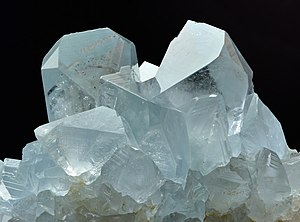I welcome you to my user page. I've been a
Wikipedian since June 2007.
Before you continue

To contact me, go to my talk page, or for private matters, email me.
Three recent changes
List of abbreviations ( help):
- D
- Edit made at Wikidata
- r
- Edit flagged by ORES
- N
- New page
- m
- Minor edit
- b
- Bot edit
- (±123)
- Page byte size change
8 July 2024
My directory User:Harryboyles/Directory
Maintenance templates
Community portal tasks
You can help improve the articles listed below! This list updates frequently, so check back here for more tasks to try. (See Wikipedia:Maintenance or the Task Center for further information.)
Help counter systemic bias by creating new articles on important women.
Help improve popular pages, especially those of low quality.
Active Wiki Fixup Projects - - - Resources for maintenance and collaboration
|
"
Wikipedia:Motto of the day/July 8, 2024"
Favourite mottos
Celestine is a mineral consisting of strontium sulfate ( Sr S O4). It is named for its occasional delicate blue color. Celestine and the carbonate mineral strontianite are the principal sources of the element strontium, commonly used in fireworks and in various metal alloys. The mineral occurs as crystals, and also in compact massive, and fibrous forms. It is found worldwide, mostly found in sedimentary rocks, usually in small quantities. Pale blue crystal specimens, as shown in this photograph, are found in Madagascar.
Photograph credit: Ivar LeidusRoboCop is a 1987 American science fiction action film directed by Paul Verhoeven and written by Edward Neumeier and Michael Miner. Set in a crime-ridden Detroit in the near future, it centers on police officer Alex Murphy, played by Peter Weller (pictured), who is murdered by a gang of criminals and revived by the megacorporation Omni Consumer Products as a cyborg. The director emphasized violence throughout the film, making it so outlandish that it became comical. RoboCop was a financial success upon its release in July 1987, earning $53.4 million. Reviewers praised it as a clever action film with deeper philosophical messages and satire, but were conflicted about the violence. The film won the Academy Award for Best Sound Editing. RoboCop has been critically reevaluated since its release and hailed as one of the best films of the 1980s for its depiction of a cyborg coming to terms with the lingering fragments of its humanity. ( Full article...)
Appendix
I welcome you to my user page. I've been a
Wikipedian since June 2007.
Before you continue

To contact me, go to my talk page, or for private matters, email me.
Three recent changes
List of abbreviations ( help):
- D
- Edit made at Wikidata
- r
- Edit flagged by ORES
- N
- New page
- m
- Minor edit
- b
- Bot edit
- (±123)
- Page byte size change
8 July 2024
My directory User:Harryboyles/Directory
Maintenance templates
Community portal tasks
You can help improve the articles listed below! This list updates frequently, so check back here for more tasks to try. (See Wikipedia:Maintenance or the Task Center for further information.)
Help counter systemic bias by creating new articles on important women.
Help improve popular pages, especially those of low quality.
Active Wiki Fixup Projects - - - Resources for maintenance and collaboration
|
"
Wikipedia:Motto of the day/July 8, 2024"
Favourite mottos
Celestine is a mineral consisting of strontium sulfate ( Sr S O4). It is named for its occasional delicate blue color. Celestine and the carbonate mineral strontianite are the principal sources of the element strontium, commonly used in fireworks and in various metal alloys. The mineral occurs as crystals, and also in compact massive, and fibrous forms. It is found worldwide, mostly found in sedimentary rocks, usually in small quantities. Pale blue crystal specimens, as shown in this photograph, are found in Madagascar.
Photograph credit: Ivar LeidusRoboCop is a 1987 American science fiction action film directed by Paul Verhoeven and written by Edward Neumeier and Michael Miner. Set in a crime-ridden Detroit in the near future, it centers on police officer Alex Murphy, played by Peter Weller (pictured), who is murdered by a gang of criminals and revived by the megacorporation Omni Consumer Products as a cyborg. The director emphasized violence throughout the film, making it so outlandish that it became comical. RoboCop was a financial success upon its release in July 1987, earning $53.4 million. Reviewers praised it as a clever action film with deeper philosophical messages and satire, but were conflicted about the violence. The film won the Academy Award for Best Sound Editing. RoboCop has been critically reevaluated since its release and hailed as one of the best films of the 1980s for its depiction of a cyborg coming to terms with the lingering fragments of its humanity. ( Full article...)
Appendix




















